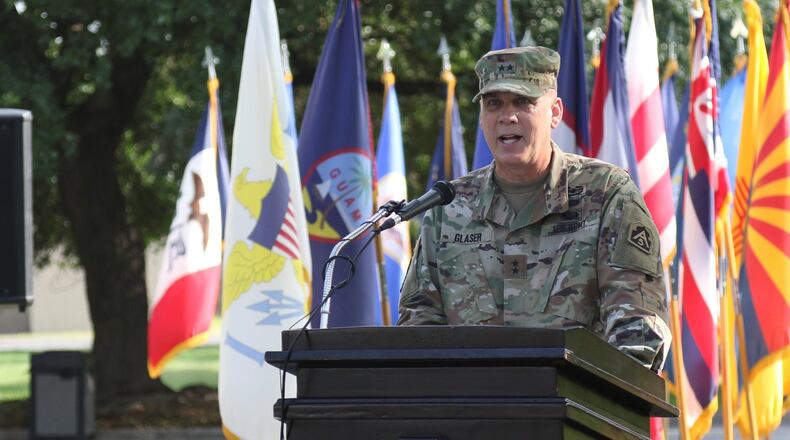“I don’t want to give up on it yet,” said Glaser, a 1981 graduate of the westside Cincinnati high school, said of the graduation.
CORONAVIRUS: Confused about unemployment? We answer your questions.
U.S. Army North is a component of the U.S. Northern Command and is the Joint Force Land Component Command with 9,000 soldiers, sailors and marines assigned. Their mission is to provide support and defense for “complex catastrophes,” such as combating COVID-19.
“We’re spread across right now eight states supporting medical operations at the request of FEMA, who acts at the behest of states,” said Glaser.
Much of Glaser’s career has involved training to fight something he can see. However, this is something his command plans for, he said. As an example, there is a chemical, biological radiological and nuclear (CBRN) response enterprise underneath his command that conducts 60 exercises a year in conjunction with FEMA and states.
The Army North deputy commander said the U.S. Northern Command conducted a CBRN exercise in the Columbus area with the National Guard.
“It was a couple thousand individuals, and we rehearsed,” said Glaser. “We adapt the exercise from state to state, and it builds in responsiveness and agility. That’s helped us tremendously during this response.”
As the military helps civilian medical professionals combat the virus, they’re learning a lot about it each day, Glaser said. But even though they plan and rehearse for various catastrophes, they have to adapt as they learn “to make sure that you’re providing the right service in the right place at the right time,” he said. “It’s hard to plan that piece of it.”
CORONAVIRUS: Nearly 60,000 Ohio businesses won $14B in paycheck protection loans
U.S. Army North was called up in January to help in the COVID-19 crisis. It helped evacuate American citizens from China, as well as those stranded on cruise ships in Japan, according to the U.S.Army.
The first COVID-19 case in the United States was confirmed in January when a man from Washington state returned home from a recent trip to Wuhan, China, the city where the first reported cases occurred. Community spread in the United States was first reported in late February with a California patient who had no travel history to an outbreak area, or contact with anyone diagnosed with the virus.
On the verge of spring, states began setting restrictions to slow the spread, and President Donald Trump declared a national state of emergency on March 13.
“We pushed a bunch of medical assets where the modeling was really bad,” Glaser said.
Army North stays focused on COVID-19, and if the modeling remains true, he said the virus outbreak could level off “at a manageable level” for state and local resources by June.
“What that means for us is we just shift our focus back to our core mission,” said Glaser. That includes homeland defense, which includes civil support.
CORONAVIRUS: Atrium doctor, husband design device to protect health care workers from coronavirus
“This summer, of course, we’ll start seeing hurricane season come up, and little deeper in the year we have wildland firefighting, and everpresent is the threat of earthquakes,” he said.
TIMELINE
Some of the significant actions taken by the U.S. Army North in response to the COVID-19 national emergency:
March 26: U.S. Army North requested unit deployment to provide defense support of civil authorities in response to the COVID-19 national emergency. The Department of Defense established a command and control framework to have military support for U.S. government partners. Active-duty units supporting the mission include the Joint Task Force-Civil Support Headquarters from Joint Base Langley-Eustis, Va.; 3rd Expeditionary Sustainment Command from Ft. Bragg, NC; 4th Sustainment Brigade, 4th Infantry Division from Fort Carson, Colo.; and 63rd Expeditionary Signal Battalion from Fort Stewart, Ga. In total, approximately 1,100 people are deploying to help communities in need.
March 28: The U.S. Army North requested additional units deploy for defense support of civil authorities. The additional troops will further enable the Department of Defense to rapidly employ military capabilities to support our whole-of-nation response. The additional units mobilizing include Task Force 46 Headquarters, formed by the 46th Military Police Command from Lansing, Mich. (National Guard); 263rd Army Air and Missile Defense Command Headquarters from Anderson, S.C. (National Guard); Task Force 76 Headquarters, formed by the 76th Operational Response Command from Salt Lake City, Utah (U.S. Army Reserve); 377th Theater Sustainment Command Headquarters from New Orleans, La. (U.S. Army Reserve); 4th Expeditionary Sustainment Command Headquarters from San Antonio, Texas (U.S. Army Reserve); and 505th Military Intelligence Brigade Headquarters from San Antonio, Texas (U.S. Army Reserve).
April 7: 325 Department of Defense medical professionals were deployed to assist 11 New York City hospitals. Each hospital received 20 to 30 military medical personnel to support the hospital staff. The DoD sent doctors, physician's assistants, nurse practitioners, nurses, respiratory therapists and other medical professionals. The support mission is in addition to the 775 military medical personnel to support the Javits New York Medical Station and on the USNS Comfort.
April 9: The U.S Northern Command's Joint Force Land Component Command (JFLCC) reported approximately 5,700 service members are assisting state and local governments in response to the COVID-19 pandemic, including the 1,100 medical providers Army, Navy and Air Force reserves in New York City.
About the Author

